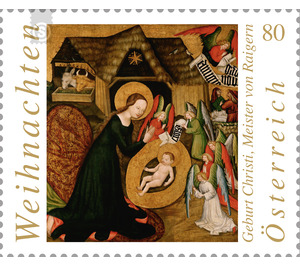Christmas - Austria / II. Republic of Austria 2016 - 80 Euro Cent
Theme: Religion & Spirituality
| Country | Austria / II. Republic of Austria |
| Issue Date | 2016 |
| Face Value | 80.00 |
| Edition Issued | 500,000 |
| Printing Type | offset |
| Stamp Type | Commemorative |
| Item Type | Stamp |
| Chronological Issue Number | 2639 |
| Chronological Chapter | OOS-OE2 |
| SID | 471289 |
| In 51 Wishlists | |
It is a painting from the Kunsthistorisches Museum Vienna, which serves as a template for this commemorative stamp. It is simply said that "Nativity" is attributed to an artist who is called the master of Raigern. There is little to know about this, he worked in South Bohemia in the first third of the 15th century. The Bohemian School of Painting is commonly known in art history as a group of painters who worked in Bohemia during this time. They began to develop their own Gothic painting style and made Prague and its surroundings the center of culture, not least through the support of the court of Charles IV and Wenceslas IV. Numerous panel paintings and other works for churches and monasteries in the area were created. From said master of Raigern or masters of the altar of Raigern are panel paintings, which were decisive for this era. The painting "Nativity", which belongs to an altarpiece, was created around 1425. The word altar fork designates an altarpiece or an altar back wall. The Kunsthistorisches Museum Wien also possesses a second picture from the same altarpiece by the master of Raigern, which shows the embarkation of the bones of Saint James the Elder to Spain and was made the same year. The image "Nativity" is 81 by 75 inches tall and was acquired in 1910 by the Austrian Gallery, commonly known as Belvedere. In 1922 it came into the possession of the Kunsthistorisches Museum Vienna. The birth of Christ, as the observer has the impression, is rendered particularly luminous here. On the one hand, the crib, in which the baby Jesus is lying, seems to be gold-like, on the other hand, the sky also has the same color as the widely visible star and the halo of Mary and Jesus. The two-colored wings of the angels, who bow their heads to the newborn, look particularly splendid, as does Maria's long, dark green robe. The baby Jesus himself is depicted naked. Even the shepherds are clothed in cloths that seem to shine. It was probably a concern of the master of Raigern to show this holy night as a particularly enlightened one.


